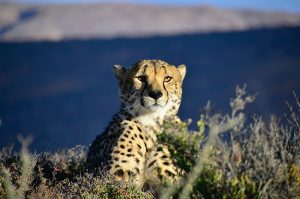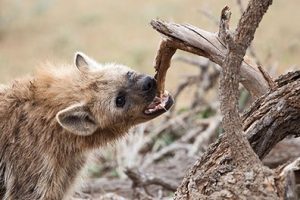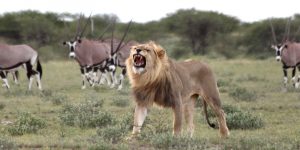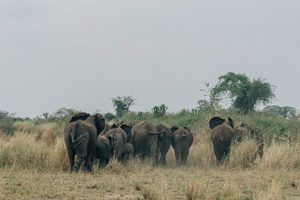The Mana Pools National Park in Zimbabwe has been designated as a UNESCO World Heritage Site due to the park’s unspoiled natural beauty. The park is home to about 350 different kinds of birds, in addition to a wide variety of mammalian and aquatic animals. The national park known as Mana Pools is considered by Gateway magazine to be the fifth best park in all of Africa. Because of its unspoiled nature and breathtaking scenery, it has been designated as a prestigious World Heritage Site (still has dinosaur spoors). One of the most unspoiled natural and ecological locations in the whole wide planet.


The majority of large game species make their way up the escarpment during the wet season, moving away from the river in the process. Around the month of April, as the pans in the jungle begin to dry up, they begin to return to the riverine areas.


Large herds of elephants and buffaloes can be observed over the course of the year, in addition to kudus, elands, waterbucks, zebras, impalas, and a wide variety of other antelope species. Because the wildlife in Mana Pools is not particularly bothered by the presence of people on foot, the park is considered one of the best national parks in Africa for walking safaris.
The Mana Pools National Park features exceptional paddling opportunities and river fishing spots, in addition to its one-of-a-kind guided and unguided hikes amid the park’s abundant wild creatures.
It is a place of tremendous natural beauty and a diverse array of magnificent fauna. The Zambezi River has been steadily moving eastward over hundreds of years, and while it has done so, it has left behind the remnants of former river channels, which have since formed numerous small ponds and pools that are used seasonally across an area that is several hundred square kilometers in size.
These extend many kilometers back from the river and are characterized by the presence of large mahogany and acacia trees, which provide luxuriant shade to the terraces of fertile land.
Today, Mana Pools, which is one of Zimbabwe’s four World Heritage Sites, serves as the setting for one of the greatest natural spectacles in Africa. During the long, hot African summer, hordes of animals are drawn to the area around Mana Pools because of the abundance of water and the lush grazing along its banks. Mana Pools is one of Zimbabwe’s four World Heritage Sites.
A great number of antelope species, including zebras, kudus, elands, impalas, and others, as well as lions, leopards, hyenas, and wild dogs, are able to flourish.
The sanctuary is home to approximately 16,000 buffaloes and over 12,000 elephants, making it one of the regions with the highest populations of these species.
It is also one of only two pockets in the country that have nyala. Female elephants in the region often do not have tusks and are known to be significantly more aggressive than their counterparts who do.
Hippos enjoy the early morning light along the riverbank, which is home to one of the most abundant and diverse populations of avian life in the world. Later in the day, they stay cool by remaining almost totally buried in the river. They do this to keep from overheating, and they do it while sharing their hidden sandbanks with crocodiles that are nearly undetectable.
There are more than 350 different species of birds, which is enough to make any ornithologist feel overwhelmed. Many species of birds, including Goliath herons, Egyptian geese, Spurwing geese, cormorants, storks, beautifully colored bee-eaters, and kingfishers, congregate along its banks. Vultures, plovers, the Nyasa lovebird, the yellow-spotted nicator, the white-collared pratincole, the Livingstone’s flycatcher, the banded snake-eagle, and the stereotypical icon of Africa, the black and white fish eagle, all make their homes in the riverine forest and mopane forests respectively.
In the river, different species of fish, including tiger fish, bream, tilapia, vundu, nkupi, chessa, electric fish, eel fish, cornish jack, and lung fish, compete with and hunt one another.
A significant number of forest trees and plants are an essential component of the continuity chain that makes up Mana Pool.
The apple ring acacia is what keeps the elephant herds alive throughout the difficult dry season that occurs between the months of October and November. These magnificent trees contribute to the park’s one-of-a-kind gorgeous setting, which is one of the reasons why visitors come here.
Visitors to Mana Pools National Park have the opportunity to experience nature in its purest form by participating in an unguided walk that is exclusive to the park. Canoeing, both guided and unguided, is a popular activity that can be enjoyed all along the Zambezi River.
Mana Pools National Park in northern Zimbabwe is a 219,600-hectare wildlife conservation area and national park. After each rainy season, the flood plain of Zimbabwe’s lower Zambezi River transforms into a vast expanse of lakes. The region attracts many large animals in search of water as the lakes gradually dry up and recede, making it one of Africa’s most renowned game viewing regions.
In 1984, the park was inscribed as a single UNESCO World Heritage site (for a total of 676,600 ha) with the Sapi Safari Area (118,000 ha) and Chewore Safari Area (339,000 ha).
On January 3, 2013, the Mana Pools were designated as a Ramsar wetland of international importance.
Ecology
Mana means “four” in Shona, referring to the four large permanent pools formed by the middle Zambezi’s meanderings. One of Southern Africa’s least developed national parks, with 2,500 square kilometers of river frontage, islands, sandbanks, and pools surrounded by forests of mahogany, wild figs, ebonies, and baobabs. It has the highest concentration of hippopotami and crocodiles in the country, as well as large dry season mammal populations of zebra, elephant, and Cape buffalo. Other threatened species found in the area include the lion, cheetah, and Cape wild dog, as well as near-threatened leopard and brown hyena.
When UNESCO designated the area, it was one of the most important refuges for eastern black rhinoceros populations in Africa, with approximately 500 animals. Poaching had reduced these to only 10 remaining rhinos by 1994, which were relocated to another area for their protection.
Mana Pools Climate
When is the best time to see wildlife in Mana?
August, September, October, and early November are the greatest times to observe animals in this park. Due to the great scarcity of water in the interior, the animals have naturally flocked to the river and natural pools of Mana.
During the dry season, Mana Pools National Park in Zimbabwe offers walking safaris.
Mana Pools is currently experiencing its dry season.
During the rainy season, which lasts from late November to April, an entirely different park appears. Arid savannahs become verdant plains with abundant grazing. Some permanent species remain, despite the fact that many animals disperse inland and make game viewing difficult. This is the verdant season, and it is during this time that the park and its inhabitants are revitalized by the availability of food. There are newborn animals everywhere, and the bird population is enormous. Frequently, road access is restricted.
How To Get There: Mana Pools National Park Directions
Manapools is a secluded park. The park is located in the extreme north of Zimbabwe on the Zambezi River, far from any major town or human settlement. Drive approximately 310 kilometers from Zimbabwe’s capital city (Harare) and obtain a free Manapools entry permit from Marongora reception. The Marongora reception is located in the heart of the Zambezi escarpment. After obtaining the permit, you descend the Zambezi escarpment for approximately 10 kilometers before turning right onto a dirt road that will take you approximately 77 kilometers into unspoiled bush to Nyamepi Camp.
When returning from Chirundu, you obtained the same free permit from the Zimbabwe Parks office at the Chirundu border posts. Proceed from the Chirundu border post to the Manapools turnoff, which is 40 kilometers along the Harare highway.
What to bring with you
The Park is generally isolated and remote from any business center. Because the nearest shops and fuel supplies are nearly 100 kilometers away, visitors should come prepared.
Vehicle must be strictly 44.
Camping gear for campers
Tsetse fly and mosquito repellent
Because there are no shops nearby, bring enough food and fuel.
Binoculars, camera, and travel books
Where To Stay: Mana Pools National Park
Mana Pools National Park is a great place to stay.
Lodges, a communal campsite with ablution facilities, and exclusive campsites where the visitor can be alone are among the tourist facilities.
Lodges;
The Park has five lodges, all of which are located along the Zambezi River. Musangu and Muchichiri are two large lodges located a short distance upstream from Nyamepi Camp. These lodges include a bathroom with a shower and hot and cold running water, two toilets, and a fully equipped kitchen with a stove, deep freezer, and all utensils such as cutlery, crockery, and cooking utensils. All bedding and towels are provided. There is a large dining room and lounge, as well as an outside braai area with a sitting area from which to view the river and the wildlife that comes down to drink, or simply watch the African sun set over the Zambezi River. There are also three four-bedroom lodges with thatch. Each lodge has two bedrooms with two beds each, a shower and toilet, and outdoor seating areas near the Zambezi River. A deep freezer, cooker, crockery and cutlery, and other cooking implements are provided in the kitchen. Bedding and towels are provided.
Camping Areas;
Along the Zambezi River, there is one large communal campsite and a number of exclusive campsites where visitors can ensure their privacy.
Communal Camping Area;
The Nyamepi camping area is near the Mana Pools National Park reception office and is located along the Zambezi River. Visitors must bring their own camping equipment, bedding, toiletries, cooking utensils, and so on. There are nearby restrooms with hot and cold running water, flush toilets, and laundry sinks. Firewood can be purchased at the reception desk, and each campsite has a braai area. This campground has 30 campsites.
Exclusive Campground;
Along the Zambezi River, there are a number of exclusive campsites. These camps are for visitors who seek solitude and want to truly experience the wilderness and its challenges. Each site has a braai stand and a rudimentary toilet. Water is drawn from the river or from the reception area. Visitors to these sites must be fully self-sufficient and capable of dealing with the remoteness and solitude of these unique camps. The camps are limited to two vehicles and twelve people per stay. The river can be tapped for water.
